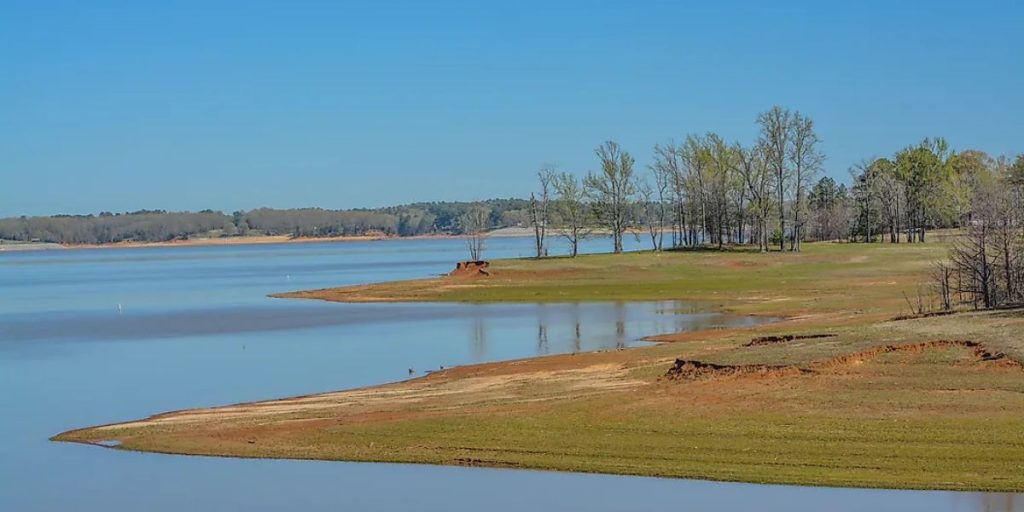Although the Mississippi River gets all the attention, it’s not the only body of water in the state. You may go swimming, boating, and fishing in the Mississippi lakes. Be cautious of snakes whether you’re going to spend the day at the beach or pitch a tent along the serene Mississippi shore. Venomous snakes, of which there are several species in Mississippi, can put a damper on any outdoor activity and necessitate prompt medical attention. Keep your distance from these animals, particularly near the water.
Horn Lake
Horn Lake, located in Mississippi, is an oxbow lake that was created after a former Mississippi River channel was cut off and began to meander. This candy cane-shaped lake, which the locals call “Mud Lake,” was formerly a branch of the Mississippi River. Situated about 17 miles from Memphis’s western side and 12 miles from the Southaven, Mississippi suburb, this lake is located just south of the Tennessee state line.
Apex Wildlife Control is one of several snake removal businesses in this town. Venomous snakes look like cats when they’re at rest: triangle heads, pointed snouts, and eyes with slit pupils. The heads and snouts of non-venomous snakes are more rounded, and their pupils are often spherical as well. Typically seen near bodies of water, the cottonmouth snake—brown with darker brown bands—is the most common venomous snake in Mississippi. Cottonmouths get their name from the fact that, when frightened, they frequently “gape” (show the white interior of their lips).
Enid Lake
Despite its diminutive size, Enid Lake is inhabited by robust serpents. Throughout the years, people have noticed them in this lake. Some of them are big enough to maybe lift their heads above the sides of small boats. The huge serpents seen in Enid Lake were probably common watersnakes, which are sometimes confused with cottonmouths, although there are dangerous snake species that can swim.
Typically, water snakes have a yellow body with brown bands that are widely spaced. However, as they age, the bands may deepen and eventually turn entirely black. They can reach a length of 4.5 feet in nature and can be found with bellies that are white, yellow, gray, or reddish with black crescents.

Day and night, these watersnakes slither around the shore in search of insects, frogs, and tiny fish. Basking on lakeshores or along stream banks is a common sight, but be warned: they’ll slide into the water if you disturb them. Although they do not contain any poison, the bite can be rather painful.
Grenada Lake
The fauna of Grenada Lake is well-known. For the sake of the many species that call this 35,000-acre lake home, the Mississippi Department of Wildlife, Fisheries, and Parks oversees its management. As a result, Grenada Lake had one of the liveliest and healthiest ecosystems in all of Mississippi.
At the base of the lake, among 1,200 fallen cedar trees, you’ll find a fantastic fishing spot where the local crappie thrive. Indeed, Grenada Lake has earned the reputation as America’s premier crappie fishing destination! All are welcome to cast a line, and each year hundreds of young athletes participate in the Thunder on Water Safe Boating Festival Children’s Fishing Rodeo.
Read More: Hurried Escape from Mississippi: 5 Towns People Are Leaving Behind
Many coral snakes call Grenada Lake home as well, thanks to its rich ecosystem. The ones seen in Mississippi are very striking, with yellow bands surrounding the head and huge red and black bands that alternate with tiny yellow bands. Unless it’s raining, you won’t see these creatures very often; they spend much of their time underground or among leaves. Coral snakes are poisonous, although they aren’t violent or aggressive, and they only account for 1% of snake bites treated in the US.
Sardis Lake
Located on the Little Tallahatchie River and adjacent to the Sardis Dam is the reservoir known as Sardis Lake. Longtime residents rave about the sandy beaches and the abundance of fish in the area, including sunfish, crappie, bass, catfish, and bluegill. At the Sardis Lake Marina, you may rent boats, tubes, skis, and wakeboards, making this lake ideal for water sports. A swimming pool and leisure hall are available for use on days when it rains, and there are lots of campsites for people who want to stay the night.
Having said that, rattlesnakes are abundant in the area around Sardis Lake. These menacing serpents get their rattle from a network of interconnecting scales at the tail’s tip, which the snake replenishes with each molt. Be cautious of these tan and brown-striped serpents if you go hiking near the lake or play golf in the area; they are poisonous but can only bite when coiled.
Also Read: Forgotten Tales: There’s a Little-Known Abandoned Town in Mississippi
Conclusion
While the Mississippi lakes are picturesque, the local fauna poses a real threat. Nevertheless, snakes play a crucial role in ecosystems by providing natural predators with food. Without snakes, rats and other pests would quickly become an infestation.
Hikers should exercise extreme caution when traversing the forests, marshes, or coastlines of a lake in Mississippi, as well as when bending over logs or clambering under rocks. Make an immediate 911 call or go to the emergency room if you are bitten by a snake.